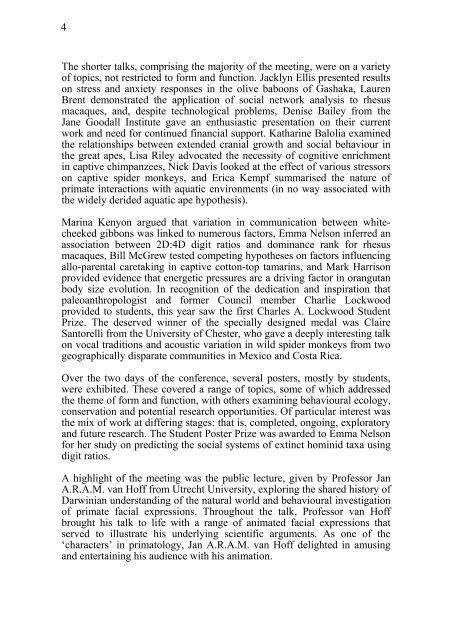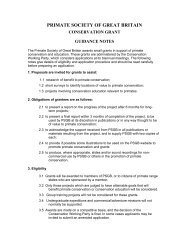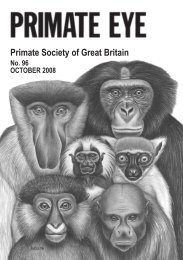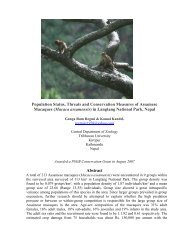2009 Vol 99.pdf (2.45mb) - Primate Society of Great Britain
2009 Vol 99.pdf (2.45mb) - Primate Society of Great Britain
2009 Vol 99.pdf (2.45mb) - Primate Society of Great Britain
You also want an ePaper? Increase the reach of your titles
YUMPU automatically turns print PDFs into web optimized ePapers that Google loves.
4<br />
The shorter talks, comprising the majority <strong>of</strong> the meeting, were on a variety<br />
<strong>of</strong> topics, not restricted to form and function. Jacklyn Ellis presented results<br />
on stress and anxiety responses in the olive baboons <strong>of</strong> Gashaka, Lauren<br />
Brent demonstrated the application <strong>of</strong> social network analysis to rhesus<br />
macaques, and, despite technological problems, Denise Bailey from the<br />
Jane Goodall Institute gave an enthusiastic presentation on their current<br />
work and need for continued financial support. Katharine Balolia examined<br />
the relationships between extended cranial growth and social behaviour in<br />
the great apes, Lisa Riley advocated the necessity <strong>of</strong> cognitive enrichment<br />
in captive chimpanzees, Nick Davis looked at the effect <strong>of</strong> various stressors<br />
on captive spider monkeys, and Erica Kempf summarised the nature <strong>of</strong><br />
primate interactions with aquatic environments (in no way associated with<br />
the widely derided aquatic ape hypothesis).<br />
Marina Kenyon argued that variation in communication between whitecheeked<br />
gibbons was linked to numerous factors, Emma Nelson inferred an<br />
association between 2D:4D digit ratios and dominance rank for rhesus<br />
macaques, Bill McGrew tested competing hypotheses on factors influencing<br />
allo-parental caretaking in captive cotton-top tamarins, and Mark Harrison<br />
provided evidence that energetic pressures are a driving factor in orangutan<br />
body size evolution. In recognition <strong>of</strong> the dedication and inspiration that<br />
paleoanthropologist and former Council member Charlie Lockwood<br />
provided to students, this year saw the first Charles A. Lockwood Student<br />
Prize. The deserved winner <strong>of</strong> the specially designed medal was Claire<br />
Santorelli from the University <strong>of</strong> Chester, who gave a deeply interesting talk<br />
on vocal traditions and acoustic variation in wild spider monkeys from two<br />
geographically disparate communities in Mexico and Costa Rica.<br />
Over the two days <strong>of</strong> the conference, several posters, mostly by students,<br />
were exhibited. These covered a range <strong>of</strong> topics, some <strong>of</strong> which addressed<br />
the theme <strong>of</strong> form and function, with others examining behavioural ecology,<br />
conservation and potential research opportunities. Of particular interest was<br />
the mix <strong>of</strong> work at differing stages: that is, completed, ongoing, exploratory<br />
and future research. The Student Poster Prize was awarded to Emma Nelson<br />
for her study on predicting the social systems <strong>of</strong> extinct hominid taxa using<br />
digit ratios.<br />
A highlight <strong>of</strong> the meeting was the public lecture, given by Pr<strong>of</strong>essor Jan<br />
A.R.A.M. van H<strong>of</strong>f from Utrecht University, exploring the shared history <strong>of</strong><br />
Darwinian understanding <strong>of</strong> the natural world and behavioural investigation<br />
<strong>of</strong> primate facial expressions. Throughout the talk, Pr<strong>of</strong>essor van H<strong>of</strong>f<br />
brought his talk to life with a range <strong>of</strong> animated facial expressions that<br />
served to illustrate his underlying scientific arguments. As one <strong>of</strong> the<br />
‘characters’ in primatology, Jan A.R.A.M. van H<strong>of</strong>f delighted in amusing<br />
and entertaining his audience with his animation.






